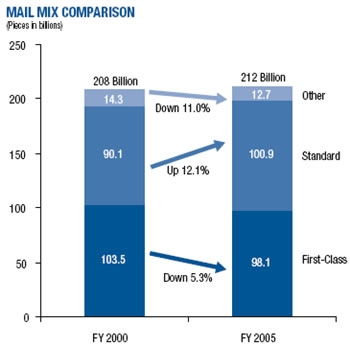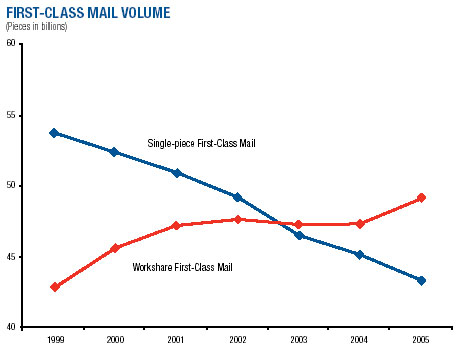 |
page 22 of 66 |  |
Financial review
Part II
|
(Dollars in millions) % Change
Note: Percentages are calculated based on unrounded numbers.
|
First-Class Mail volume, which was our largest mail class until 2004, increased slightly in 2005 after declining for three consecutive years. The increase in workshare First-Class Mail pieces (up 1.8 billion pieces or 3.7%) offset the continuing decline in single-piece volume (down 1.8 billion pieces or 4.0%). The long-term continued decline in single piece volume reflects the impact of electronic diversion as businesses, nonprofit organizations, governments, and households increasingly automate all transactions and divert correspondence to the Internet. The consolidation in the pre-bar-coded mailer market and anecdotal evidence suggests that some of the single piece First-Class Mail may be migrating to workshare First-Class Mail. Following several years of essentially no change in workshare First-Class Mail volume, volume grew in 2005, driven by the advertising and financial markets. After declining for four consecutive years, Priority Mail volumes increased. Four factors underlie this performance. First, Priority Mail rates have stayed steady for three years while competitors’ published rates have increased annually. Second, the proliferation of competitors’ surcharges for fuel, residential delivery, and delivery in rural areas make Priority Mail increasingly attractive, especially for small-volume users, who generally cannot negotiate discounts or other pricing concessions with private sector competitors. Third, Priority Mail is easier to use than ever. Customers can purchase postage and print mailing labels with free delivery confirmation on-line through Click-N-Ship or on websites such as eBay. The Carrier Pickup online notification program saves customers a trip to the Post Office. Letter carriers averaged 4,000 daily pickups in 2005. Also contributing to growth in Priority Mail is the Priority Flat Rate Box. Launched in November 2004, revenues from this service are growing strongly. Through this service, customers can send packages via Priority Mail at a flat rate of $7.70. Two differently shaped boxes are available to customers, both with the same cubic capacity. Finally, we have worked to consistently improve Priority Mail service performance. Express Mail and Package Services have experienced similar turnarounds for many of the same reasons. Periodical Mail volume and revenue are declining, as businesses and consumers increasingly rely on the Internet as a substitute for hardcopy publication of news, information, and entertainment. Operating Expenses Operating Expenses are comprised of Compensation and Benefits, Transportation, Supplies and Services, Depreciation and Amortization and Other Expenses and are discussed in the sections to follow.
|
||||||||||||||||||||||||||||||||||||||||||||||||||||||||||||

